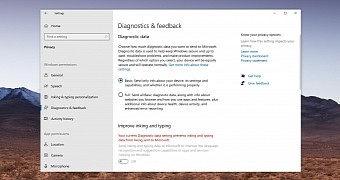The telemetry service in Windows 10 has long been a very controversial topic as far as Microsoft’s operating system is concerned, with many accusing the software giant of collecting too much information from their devices.
And while the company itself has always explained that some data is absolutely necessary to keep Windows 10 up and running and resolve any issues that users may come across, it has also bundled more advanced controls to view the data and manage the telemetry service in the OS.
As far as enterprises are concerned, Microsoft has previously provided these customers with two different options when Windows 10 was installed on their devices.
The first of the two was an option that allowed Microsoft to be the controller of everything, basically allowing the software giant to determine how it collects data to improve Windows 10.
The second was an option that just disabled the diagnostic data entirely, technically blocking Windows 10 from sending any information to Microsoft.
Microsoft is now experimenting with a third option that will allow enterprises running Windows 10 to be the one deciding what data they are sending to Microsoft, but at the same time, allow Microsoft to be the data processor. Microsoft explains:
“Customers will have a third option that allows them to be the controller for their Windows 10 diagnostic data, while still benefiting from the purposes that this data serves, such as quality of updates and device drivers. Under this approach, Microsoft will act as a data processor, processing Windows diagnostic data on behalf of the controller.”
What’s important to know is that this feature is currently available only as a preview, and customers who want to see how this works can actually give it a try before the public rollout.
Microsoft explains that it’s betting big on transparency, and the release of this new Windows diagnostic data control is a step in the right direction.
“This new option will enable customers to use familiar tools to manage, export, or delete data to help them meet their compliance obligations. For example, using the Microsoft Azure portal, customers will have the means to respond to their own users’ requests, such as delete and export diagnostic data. Admins can easily add – or remove – Windows devices to the service using group policy or mobile device management (MDM),” Microsoft says.
Worth emphasizing is that the changes that we detailed here are only aimed at enterprises, so no changes will occur for consumers.
At this point, the consumer versions of Windows 10 come with two diagnostic data options:
- Basic: Send only info about your device, its settings and capabilities, and whether it is performing properly
- Full: Send all Basic diagnostic data, along with info about websites you browse and how you use apps and features, plus additional info about device health, device activity, and enhanced error reporting.
As you can see, consumers aren’t provided with an option to disable telemetry services in Windows 10, albeit this is possible in other ways using a more complex approach and registry settings. Furthermore, there are lots of dedicated apps out there that can disable data collection entirely in Windows 10, but Microsoft obviously recommends against using them.
Windows 10, however, also comes with options to view diagnostic data, with a dedicated Diagnostic Data Viewer providing you with more information about the software giant collected from users’ computers. What’s more, the operating system also comes with a dedicated option to delete diagnostic data, with the company promising that all copies are removed from its systems as well once this trigger is activated.

 14 DAY TRIAL //
14 DAY TRIAL //